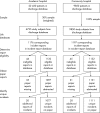Rates and types of events reported to established incident reporting systems in two US hospitals
- PMID: 17545340
- PMCID: PMC2464990
- DOI: 10.1136/qshc.2006.019901
Rates and types of events reported to established incident reporting systems in two US hospitals
Abstract
Background: US hospitals have had voluntary incident reporting systems for many years, but the effectiveness of these systems is unknown. To facilitate substantial improvements in patient safety, the systems should capture incidents reflecting the spectrum of adverse events that are known to occur in hospitals.
Objective: To characterise the incidents from established voluntary hospital reporting systems.
Design: Observational study examining about 1000 reports of hospitalised patients at each of two hospitals.
Patients and setting: 16 575 randomly selected patients from an academic and a community hospital in the US in 2001.
Main outcome measures: Rates of incidents reported per hospitalised patient and characteristics of reported incidents.
Results: 9% of patients had at least one reported incident; 17 incidents were reported per 1000 patient-days in hospital. Nurses filed 89% of reports, physicians 1.9% and other providers 8.9%. The most common types were medication incidents (29%), falls (14%), operative incidents (15%) and miscellaneous incidents (16%); 59% seemed preventable and preventability was not clear for 32%. Among the potentially preventable incidents, 43% involved nurses, 16% physicians and 19% other types of providers. Qualitative examination of reports indicated that very few involved prescribing errors or high-risk procedures.
Conclusions: Hospital reporting systems receive many reports, but capture a spectrum of incidents that differs from the adverse events known to occur in hospitals, thereby substantially underdetecting physician incidents, particularly those involving operations, high-risk procedures and prescribing errors. Increasing the reporting of physician incidents will be essential to enhance the effectiveness of hospital reporting systems; therefore, barriers to reporting such incidents must be minimised.
Conflict of interest statement
Competing interests: None.
Similar articles
-
Evaluation of an intervention aimed at improving voluntary incident reporting in hospitals.Qual Saf Health Care. 2007 Jun;16(3):169-75. doi: 10.1136/qshc.2006.019349. Qual Saf Health Care. 2007. PMID: 17545341 Free PMC article. Clinical Trial.
-
Can Patient Safety Incident Reports Be Used to Compare Hospital Safety? Results from a Quantitative Analysis of the English National Reporting and Learning System Data.PLoS One. 2015 Dec 9;10(12):e0144107. doi: 10.1371/journal.pone.0144107. eCollection 2015. PLoS One. 2015. PMID: 26650823 Free PMC article.
-
Incident reporting in one UK accident and emergency department.Accid Emerg Nurs. 2006 Jan;14(1):27-37. doi: 10.1016/j.aaen.2005.10.001. Accid Emerg Nurs. 2006. PMID: 16321534
-
Reporting of Adverse Drug Events: Examination of a Hospital Incident Reporting System.In: Henriksen K, Battles JB, Marks ES, Lewin DI, editors. Advances in Patient Safety: From Research to Implementation (Volume 1: Research Findings). Rockville (MD): Agency for Healthcare Research and Quality (US); 2005 Feb. In: Henriksen K, Battles JB, Marks ES, Lewin DI, editors. Advances in Patient Safety: From Research to Implementation (Volume 1: Research Findings). Rockville (MD): Agency for Healthcare Research and Quality (US); 2005 Feb. PMID: 21249793 Free Books & Documents. Review.
-
Analysis of Patient Safety Incident reporting system as an indicator of quality nursing in critical care units in KwaZulu-Natal, South Africa.Health SA. 2020 Mar 31;25:1263. doi: 10.4102/hsag.v25i0.1263. eCollection 2020. Health SA. 2020. PMID: 32284886 Free PMC article. Review.
Cited by
-
The informatics opportunities at the intersection of patient safety and clinical informatics.J Am Med Inform Assoc. 2008 Jul-Aug;15(4):397-407. doi: 10.1197/jamia.M2735. Epub 2008 Apr 24. J Am Med Inform Assoc. 2008. PMID: 18436896 Free PMC article.
-
Medication-related adverse events in health care-what have we learned? A narrative overview of the current knowledge.Eur J Clin Pharmacol. 2022 Feb;78(2):159-170. doi: 10.1007/s00228-021-03213-x. Epub 2021 Oct 6. Eur J Clin Pharmacol. 2022. PMID: 34611721 Free PMC article. Review.
-
The Risks and Outcomes Resulting From Medication Errors Reported in the Finnish Tertiary Care Units:: A Cross-Sectional Retrospective Register Study.Front Pharmacol. 2020 Jan 17;10:1571. doi: 10.3389/fphar.2019.01571. eCollection 2019. Front Pharmacol. 2020. PMID: 32009966 Free PMC article.
-
Major sources of critical incidents in intensive care.Crit Care. 2011;15(5):R232. doi: 10.1186/cc10474. Epub 2011 Sep 29. Crit Care. 2011. PMID: 21958492 Free PMC article.
-
Quality management in radiation therapy: A 15 year review of incident reporting in two integrated cancer centres.Tech Innov Patient Support Radiat Oncol. 2020 Mar 9;14:15-20. doi: 10.1016/j.tipsro.2020.02.001. eCollection 2020 Jun. Tech Innov Patient Support Radiat Oncol. 2020. PMID: 32181375 Free PMC article.
References
-
- Agency for Healthcare Research and Quality Detail of performance analysis table, quality/safety of patient safety portfolio. Budget estimates for Appropriations Committees, fiscal year 2006. Available at: http://www.ahrq.gov/about/cj2006/cj06exbua.htm (accessed 31 Mar 2007)
-
- S 544. The Patient Safety and Quality Improvement Act of2005
-
- United Kingdom National Patient Safety Agency Seven steps to patient safety—your guide to safer patient care. Available at: http://www.npsa.nhs.uk/health/resources/7steps (accessed 31 Mar 2007)
-
- Runciman W B. Iatrogenic injury in Australia. A report by the Australian Patient Safety Foundation for the National Health Priorities and Quality Branch. Canberra, 2000. Available at: http://www.apsf.net.au/dbfiles/Iatrogenic_Injury.pdf (accessed 31 Mar 2007)
Publication types
MeSH terms
Grants and funding
LinkOut - more resources
Full Text Sources


